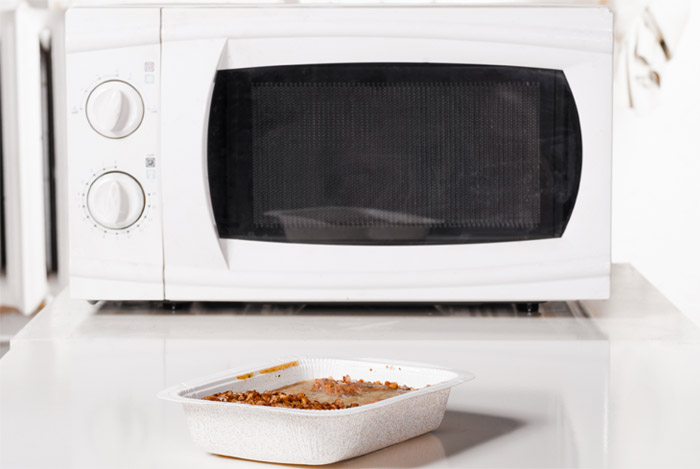When I was researching the best cooking methods to maximize the nutritional value of your food, I came across conflicting information about microwave cooking.
It seems like this one electronic device has cooked up a storm of polarizing beliefs and concerns.
While some argue that microwave cooking is perfectly safe, others warn that it can give you heart problems, cancer, and ‘kill’ your otherwise nutritious food.
Microwaves sit in over 90% of our kitchens, including my own. But with all of these unanswered questions, I knew I needed some serious research to help me make an educated and informed decision of my own.
So let’s talk about all the ins and outs of microwave cooking and see what conclusions we come up with.
How Do Microwaves Work?
 Microwaves save you time and money, period. They cook food fast and use way less energy than conventional ovens.
Microwaves save you time and money, period. They cook food fast and use way less energy than conventional ovens.
How do microwaves heat up your food so quickly?
Microwaves channel heat energy to the tiny molecules in your food the same way the sun heats up your skin to deliver your daily dose of vitamin D – by radiation.
The water molecules in your food vibrate at very high frequencies, like when you rub your hands together to create friction on a cold day.
This hot water basically turns to steam, which is what really heats or cooks your food and why foods with higher water content cook faster.
The outer layers of your food get heated by the microwaves and the inside gets cooked from the conduction of that heat towards the center. Contrary to popular belief, microwaves don’t cook your food from the inside out, but actually the opposite.
To ensure even cooking, most new microwaves have a rotating tray to make sure the waves get distributed to your food all over. Still, occasional “hot spots” and icy spots will exist in larger quantities of food being cooked.
That’s because microwaves work with water molecules and not all areas of your food contain the same amount of water.
Now I know that all makes sense, but I bet you’re still a little freaked out because I said the word ‘radiation’.
But don’t worry; microwaves rank on the low energy side of the electromagnetic radiation spectrum. You have X-rays on the high end and things like radio waves and TV remotes on the low end.
Microwaves use non-ionizing radiation, which is different from the ionizing radiation used in X-rays and cancer treatment.
Let’s go back to chemistry class here.
When something is ionizing, it changes the nature of the atoms, which alters the way the atoms interact with other molecules around them.
“When atoms in living cells become ionized one of three things usually happen – the cell dies, the cell repairs itself, or the cell mutates incorrectly and can become cancerous.”
However, non-ionizing radiation can change the position of atoms, but it doesn’t change their physical structure or composition. This means that microwaves can’t break apart atoms.
See the difference? If microwaves were a source of ionizing radiation, I seriously doubt they’d be allowed on the market.
There are several forms of non-ionizing radiation, most of which you encounter several times a day such as:
- Radio waves from your cell phone, television, and GPS
- Infrared waves from your toaster
- Radar, visible light, laser light, and UV light
That doesn’t mean all non-ionizing radiation is safe. At high levels it can actually be pretty dangerous.
Let’s take UV light as an example.
If we get too much UV light from a day at the beach, we get red and sunburned and put ourselves at risk for developing skin cancer. This type of non-ionizing radiation is harmful and damaging to our tissues.
Using a microwave in a normal fashion, i.e. to reheat your leftovers for a few minutes, does not count as excessive non-ionizing radiation.
So Microwaves Are Safe?
 Make no doubt about it, microwaves use a controlled form of radiation. Because of this, microwave manufacturers have to equip microwaves with metal shields to protect us from leaking radiation.
Make no doubt about it, microwaves use a controlled form of radiation. Because of this, microwave manufacturers have to equip microwaves with metal shields to protect us from leaking radiation.
The FDA has been monitoring microwave production since 1971 and they’ve made it clear that radiation emitted from microwaves is “well below the level known to harm people.”
“There have been allegations of radiation injury from microwave ovens, but none as a direct result of microwave exposure.”
You know where else we absorb electromagnetic radiation from?
- Cell phones
- Power lines
- Wireless computers and devices
- Airplanes
- Refrigerators
And the list goes on.
Radiation from microwaves is so low and there’s no conclusive data to report any directly negative impacts on our health.
So how do microwaves affect the nutrition of our food?
Microwaves and Nutrition
 Unless you’re following the raw diet, you’re going to need to cook your food at some point.
Unless you’re following the raw diet, you’re going to need to cook your food at some point.
When discussing “carrots, spinach, and tomatoes, for example, heat facilitates the release of antioxidants by breaking down cell walls, providing an easier passage of the healthy components from food to body.”
And studies show that cooking certain foods, such as tomatoes or carrots, actually increases their health benefits. You’ll get more lycopene in cooked tomatoes and higher carotenoid levels in cooked carrots.
But on the whole, “whenever you cook food, you’ll have some loss of nutrients,” says registered dietitian and certified food scientist Catherine Adams Hutt.
The main factors that contribute to nutrient degradation are high temperatures, long cooking times, and using added water, which makes water-soluble nutrients leak out of your food.
But studies show that microwaving doesn’t reduce the nutrient value of our food any more than conventional cooking methods.
Researchers from one study compared the antioxidant content of 20 different vegetables cooked by boiling, microwaving, pressure-cooking, griddling, frying, and baking.
They discovered that microwaving produced some of the “lowest losses” of antioxidants, while boiling lead to the “greatest losses.”
During one study at Cornell University, scientists discovered that spinach cooked in a microwave “retained nearly all its folate.” However, when the spinach was cooked on the stove it lost 77% of its folate.
On the other hand, another study claimed that broccoli that was microwaved lost 97% of its flavonoids while boiling that broccoli only led to a loss of 66% flavonoids.
This doesn’t bode well for super healthy and invigorating broccoli.
“It’s clear that water is not a cook’s best friend when it comes to nutrient retention, whether in the microwave or on the stovetop,” says Barry Swanson, PhD, a food science professor at Washington State University.
Swanson doesn’t agree with the results from the broccoli study and noted that “the study authors added way too much water and cooked the vegetable for longer than what would occur in a normal household situation.”
So it seems like that study should be taken with a grain of salt.
Here’s what we do know: the most heat-sensitive nutrients are folic acid and vitamins B and C.
No matter which way we cook foods containing these nutrients, we’re going to lose some percentage of their strength.
We also know that the cooking method that “best retains nutrients is one that cooks quickly, heats food for the shortest amount of time, and uses as little liquid as possible.”
Microwaving definitely meets that criteria.
By using the microwave with a very small amount of water, we essentially steam our food and keep more vitamins and minerals than almost any other cooking method.
Microwaving Prepackaged Foods & Plastics
 Plastics are another modern day convenience that make the world go round.
Plastics are another modern day convenience that make the world go round.
Think about how pervasive the use of plastics are today; just take a look around the room you’re sitting in. I can name at least 10 things that are plastic within five feet of where I’m sitting.
Would I ever put a plastic bowl over a campfire? Or toss a plastic water bottle in the oven to heat up my tea?
Absolutely not.
Plastics have a time and place, and the microwave, or any source of cooking with heat, isn’t their place.
When certain plastics are heated, they release toxic chemicals. And when you microwave your food in these plastics, those toxic chemicals leach into your food.
Many of them are known endocrine disruptors, which means these compounds mess up the way your hormones work.
The worst offender is something we’ve all heard about: bisphenol A, or BPA.
BPA is one of the highest volume chemicals produced worldwide, with over 6 billion pounds produced every year.
You’ll typically find BPA in plastic products such as certain food storage containers. When you microwave BPA products, they break down into estrogen-like compounds that mess with your hormones.
The results from one study showed that U.S. adults with high urinary concentrations of BPA are more likely to develop heart disease and diabetes.
BPA has also been linked to chronic diseases such as:
- Diabetes
- Obesity
- Reproductive disorders such as PCOS
- Cardiovascular disease
- Birth defects
- Respiratory and kidney diseases
- Breast cancer
As if that news isn’t bad enough, according to a new study:
“The vast majority of plastics, including baby bottles, leach hormone-mimicking chemicals during microwaving. In some cases, products labeled ‘BPA-free’ released chemicals having more estrogenic activity than did BPA-containing products.”
Holy guacamole.
Microwaves and Your Health
 Anti-microwave activists (they exist!) often cite a study completed by Dr. Hans Hertel, which was never published in a peer reviewed journal.
Anti-microwave activists (they exist!) often cite a study completed by Dr. Hans Hertel, which was never published in a peer reviewed journal.
Hertel claimed that when people consumed microwaved foods, they noticed decreases in their HDL cholesterol, red blood blood cells, and white blood cells.
Lowering your blood count and your good cholesterol are definitely bad results. And they were enough to make people scared of microwaves.
However, there have been no other studies to replicate Hertel’s findings.
Additionally, other scientists have criticized the study for not standing up to the scientific rigor of other studies in the field.
For one, Dr. Hertel used himself as one of the participants in the study. Second, that study only consisted of seven other participants – kind of a small sample to make sweeping allegations for a large population.
There’s zero scientific evidence to show that microwaves cause harm to your health. In fact, there’s more evidence to suggest that they’re better at preserving the nutrients in our healthiest foods than other cooking methods.
Just make sure to microwave your food in microwave-safe glass or ceramic, which last a lot longer than plastic containers that break down faster and will give you peace of mind that chemicals from your plastic aren’t leaching into your food.
There’s a lot of microwave hate out there coming from anti-microwave activists.
If you come across other articles on the internet touting microwaves as unhealthy or unsafe, just ask yourself one question: Was this information scientifically backed with clinical evidence, or is it just perpetuating fear-based urban legends of the dark nutrition world?
Do you believe the anti-microwave hype? Are you throwing away your microwave or learning how to cook better with less water? Share your thoughts with me in the comments!
The post What Microwaving Your Food Really Does appeared first on Nutrition Secrets.
http://www.nutritionsecrets.com/what-microwaving-your-food-really-does/
No comments:
Post a Comment